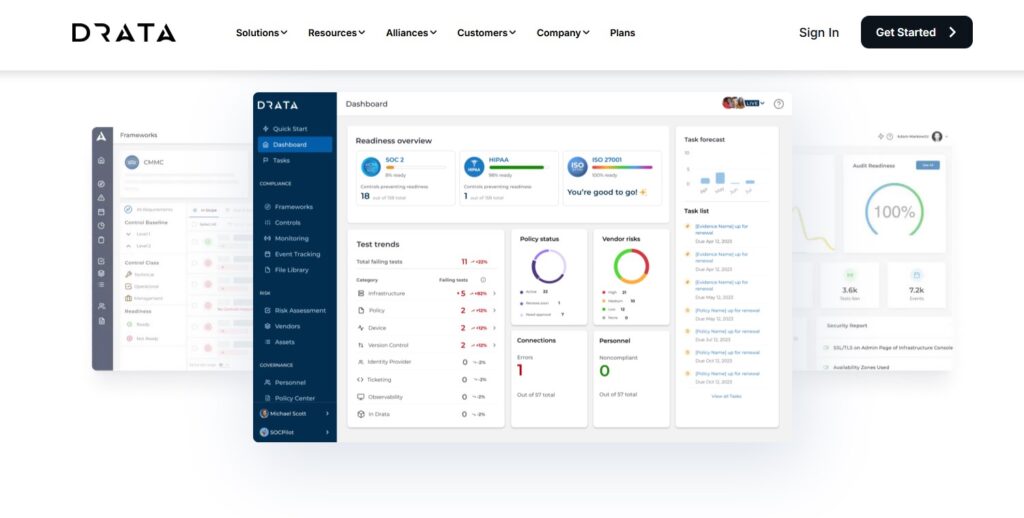The number of regulations is growing, as governments strive to create frameworks for protecting individual privacy and organizational security and resilience. Unfortunately, these regulations are making compliance management complex and effort-intensive for organizations.
This complexity has led to a need for tools that can streamline and simplify the compliance process. Drata, a cloud-based compliance automation platform, is a solution that addresses these challenges by automating key aspects of compliance management.
What is Drata?
Drata is a security and compliance automation platform designed to streamline compliance processes and ensure audit readiness. It continuously monitors and collects evidence of a company’s security controls to reduce the complexity and costs of manual compliance. Drata is built by experts who understand the challenges of compliance and have created a solution that simplifies and automates the process. Its many features automate the traditionally manual and time-consuming compliance management processes to help organizations achieve and maintain certifications more efficiently.
Key Features of Drata
Below are the key Drata features that help with compliance management and automated monitoring.
1. Continuous Monitoring
One of Drata’s standout features is its continuous monitoring. Unlike traditional compliance methods that rely on periodic audits and manual checks, Drata provides real-time monitoring of an organization’s security controls. This means that any changes or potential issues are detected immediately, allowing for prompt action. Continuous monitoring also helps maintain compliance and reduce the risk of non-compliance due to overlooked or outdated information.
2. Custom Configuration with Adaptive Automation
Compliance needs vary across organizations, which is why Drata’s Adaptive Automation offers complete configurability. With deeper integrations and more testing sources, users can build no-code tests with custom logic to automate control monitoring. This flexibility ensures that compliance processes meet the specific needs of every organization.
3. Process Control
Drata centralizes all evidence, controls, and documents, so organizations can efficiently manage every step of their compliance process. More importantly, continuous control monitoring provides full visibility into compliance status, helping organizations stay on top of risks and action items. This centralized approach makes it easier to manage compliance tasks and ensure nothing falls through the cracks.
4. Task and Ticket Management with Role-Based Access
Drata simplifies task management with its task and ticket management. Users can create compliance-related tasks and manage tickets to ensure that key compliance work is completed on time. Additionally, role-based access controls protect sensitive data and streamline workflows, ensuring that only authorized personnel can access specific information.
5. Automated Evidence Collection
Gathering evidence to demonstrate compliance is an essential but time-consuming task that’s prone to human errors. Drata automates this process by collecting evidence from various integrated systems and tools in real time. For example, Drata can automatically pull data from cloud providers, version control systems, and identity management platforms to verify that security controls are in place and functioning correctly. This automation reduces the burden on compliance teams and minimizes the risk of errors.
6. Real-Time Reporting
Drata’s real-time reporting feature provides an up-to-date view of the compliance status. Its dashboard displays key metrics and alerts, highlighting any areas that require attention. With this transparency, organizations can stay on top of their compliance obligations and quickly address any emerging issues. Additionally, it generates reports on demand, greatly simplifying the audit preparation process and making it easier to provide auditors with the necessary documentation.
7. Integrations with Existing Tools
Drata integrates seamlessly with many tools, including cloud services like AWS, identity management platforms like Okta, and version control systems like GitHub. These integrations allow Drata to automatically collect and verify data from across an organization’s technology stack, ensuring that compliance data is always accurate and up-to-date. This interconnected approach eliminates the need for manual data entry and reduces the likelihood of discrepancies between different systems.
8. Extensive Support for Different Frameworks
Drata supports over 20 frameworks, including SOC 2, ISO 27001, HIPAA, GDPR, and PCI DSS. This extensive framework support ensures that organizations can achieve and maintain compliance across various regulatory standards. Additionally, Drata supports the creation of custom frameworks and controls, enabling organizations to tailor the platform to their specific business needs.
With the above features, Drata simplifies compliance management and enables organizations to continuously stay on top of their compliance efforts.
How Drata Simplifies Compliance Management?
Drata’s automation capabilities address key challenges in compliance management. Here’s a look at the benefits that come from using this tool.
Improved Efficiency and Accuracy
Traditional compliance management involves repetitive tasks, like updating spreadsheets and compiling audit evidence. Drata automates these processes, cutting down the time and effort required. More importantly, it reduces human error that could lead to non-compliance.
Scalability
As organizations grow, maintaining compliance across multiple frameworks becomes more complex. Drata’s scalable architecture ensures that compliance processes remain efficient, even as the organization expands. This adaptability is especially valuable for rapidly growing companies managing compliance across various locations or business units.
Cost Savings
While the initial investment in Drata may be considerable, the long-term cost savings are substantial. Automation reduces the need for manual labor and lowers the risk of errors that could result in fines or other penalties. The platform’s real-time monitoring and reporting also help organizations avoid the costly disruptions associated with non-compliance.
As you can see, Drata’s features greatly reduce manual effort while improving the overall compliance posture. Continuous monitoring and real-time reporting further enable organizations to maintain strong compliance, while automated evidence collection simplifies audit preparation. Due to these features, Drata can be a handy tool for organizations that have to comply with multiple regulations.
Bottom Line
Drata is an automated platform that makes compliance more efficient, scalable, and cost-effective. While the platform is not a one-size-fits-all solution, its ability to integrate with existing tools and adapt to the unique needs of each organization makes it a valuable asset for continuous compliance. It is a handy tool for companies looking to streamline their compliance processes and reduce the burden on their teams.
